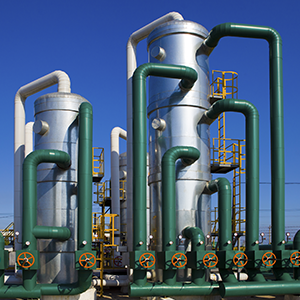Natural Gas Production Falls in 2016, Looks to Rebound in 2017
January 30, 2017

Over the past decade, the “shale revolution” has redefined natural gas production in the United States. The combination of advancements in hydraulic fracturing (fracking) and horizontal drilling opened up numerous new drilling basins in shale rock formations, increasing production nearly 50 percent in the process and driving prices lower for both natural gas and crude oil. The shale revolution has literally helped shape the global energy landscape over the past 10 years. But, for the first time since 2005, natural gas production in the United States decreased in 2016. Dry natural gas production, as measured by the Energy Information Administration (EIA), was estimated at 72.4 Bcf per day, a decrease of 1.8 Bcf per day compared to 2015’s production levels.
There are several factors that led to the decline in production. Beginning in the summer of 2015, prompt-month natural gas prices on the New York Mercantile Exchange (NYMEX) started trading under $3.00 per MMBtu, trading lower throughout the rest of the year before bottoming out in March 2016 at $1.611 per MMBtu, the lowest prompt month trade since 1998. The decline in forward pricing made it difficult for producers to lock in longer-term contracts and guarantee the necessary returns based on break-even costs of drilling, leading to a decline in drilling activity and production.
Another issue impacting production in 2016 was the amount of gas remaining in storage inventories coming out of the winter withdrawal season. Over the past 10 years, an average of 1,638 Bcf of working gas has remained in storage facilities across the country heading into injection sesaon. Coming out of the 2015-2016 withdrawal season, 2,468 Bcf of gas remained in the ground, the largest storage inventory coming out of withdrawal season of the past decade. Because of this surplus, the injection rate of gas into storage during the summer months was forced to decrease as injecting at a “normal” rate would have led to storage inventories filling up too early in the injection season. With demand soaking up as much production as it could, production had to decline in order to not over-inject into storage.
After topping out at 74.6 Bcf per day in March 2016, production has fallen to 71.95 Bcf per day in December, fluctuating between 70.5 Bcf per day and 72.0 Bcf per day since June. Despite the decline and flattening of production over the past 9 months, the EIA projects production to increase by approximately 4 percent annually through 2020. Although daily production data has yet to show an increase in production levels, underlying data paints an optimistic picture.
The natural gas-directed rig counts, a weekly survey of drilling rigs across major drilling areas, has increased to their highest levels in the past year after bottoming out in Q2 of 2016, signaling an increase in production in the coming months. Many exploration and production companies (E&P’s) across the country have also noted double-digit percent increases in expenditures in 2017 compared to 2016. The increase in expenditures coupled with increased efficiencies and lowered drilling costs E&P companies have developed during the past 1.5 years of low commodity costs also point to increased production in 2017 and beyond.
Increased production levels will be needed as new demand is on the horizon. LNG liquefaction, Mexican exports and power generation will all see increased demand in 2017, with LNG liquefaction providing the largest potential growth in the coming years. While production increases have not yet been realized, there are reasons to be optimistic that domestic gas production in 2017 will rebound.
































































































